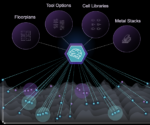Ninad Huilgol is the Founder and CEO at Innergy Systems, has extensive experience in design verification of ultra low-power mobile SoCs. Previously, he has worked in senior engineering management at various semiconductor companies such as Broadcom and Synopsys. He has multiple power- and design-related patents, trade secrets and is the recipient of a Synopsys Inventor award.
Tell us about your company.
Innergy Systems was founded in 2017 with a mission to bring power analysis to the software world, make hardware power analysis faster and provide power feedback in the earliest stages of the design flow.
I am Innergy’s founder and CEO and have extensive experience in design verification of ultra low-power mobile SoCs. I worked in senior engineering management at various semiconductor companies including Broadcom and Synopsys.
Years ago, when I was chip verification lead at Broadcom, I came across a problem designers were facing early in the development of a new ultra-low power mobile SoC. They wanted to explore the power impact of some architectural experiments. Typically, models can estimate the performance of a new architecture, but power information could not be added. We were at a design conference. One leading EDA company was asked if there was any way to get power information in performance models. The answer was a categorical no.
This led me to think about forming a startup that could build technology to bring power analysis earlier (shift left) as well as provide results faster. In the process, it led to the invention of high-performance power models capable of providing power analysis from architecture stage all the way to tape out and even beyond.
Today, Innergy counts some big-name Tier-1 chipmakers among its customers. Our models are used in all phases of hardware development, and perhaps more importantly, for developing more power efficient software.
I am a big believer in sustainability. Compute has become power hungry, driven by AI, crypto and other applications. Innergy’s technology will help build more power-efficient hardware and software systems and reduce the carbon footprint. This also saves money for our customers, which is a big bonus.
What problems are you solving?
We solve quite a few problems that exist in current power analysis solutions.
Speed: Today’s large and complex designs need power analysis solutions that run simulations quickly, so that system-level power analysis is available in minutes, not hours or days. Traditional power analysis need to run gate-level simulations that take a long time to finish and require high-performance compute.
We create power models that take a fraction of the time to run simulations without compromising accuracy. We use our proprietary, patented technology that intelligently identifies a few critical events to monitor and track power. We build higher abstraction models of power consumption. Simulating at higher abstraction requires fewer resources, which leads to significant performance gains. In RTL, a typical simulation speed up of 30x- 50x has been demonstrated. In emulation and software environments, our results demonstrated 200x-500x simulation speedup and produced without the need for high-performance compute resources.
High speed does not mean less accuracy. Our models have been consistently benchmarked with typical accuracy of 95% or better when compared to sign-off power solutions.
Root cause analysis: Currently, understanding the root cause of a power issue requires multiple iterations of running RTL simulations, power simulations and waveform analysis.
With Innergy Quarx, detailed power analysis reports show which design instances were involved in a power hotspot, along with what those instances were doing and which actions were being performed by those instances. This simplifies the debug process by not requiring multiple iterations of simulation, power analysis and waveform debug.
Ability to run with software: Designers report a difficulty to estimate power cost of software features/subroutines. Traditionally, this problem has been solved only by emulation.
Innergy Quarx enables designers to build models that run directly in a software environment by modeling events that exist in both hardware and software environments. This versatility means Quarx models can be used in RTL, emulation and software environments without requiring modification.
Early “what-if” power analysis: Currently, the only way to perform “what-if” power exploration is by building custom models, using a spreadsheet or simple modeling tools that do not have fine-grained power information.
Innergy Quarx can build power models for existing designs (evolutionary) as well as new designs (revolutionary). Even without RTL, it’s possible to build architectural-level models with estimates of power added. Our models can do power versus performance analysis at an early stage by creating virtual power simulations with different traffic patterns, voltages and frequencies. This enables designers to start realizing value right from the earliest stages of their design project through tape out and beyond.
What application areas are your strongest?
There are three:
System-level power simulations: Innergy Quarx can run subsystem or full-chip power simulations at a fraction of the time currently required. We recently benchmarked our tool against a leading power product. Quarx produced results in 26 minutes. The other tool would have required a few days’ worth of simulation. This is over 500x faster and 97% accuracy compared to the other tool.
We can handle large simulations and provide potentially 100% power coverage. Due to how slow the traditional power tools are –– some designers run only 1-2% of available stimulus to check for power consumption, which means there could be power bugs hiding in the 98-99% unused stimulus. Our solution obviates this problem.
Ability to profile power consumption of software as well as hardware: Thanks to the booming AI market, power-efficient software design is becoming important. In AI applications, hardware cores tend to be simpler in construction, repeated tens or hundreds of times in a processing system. Hardware-based power analysis might not be effective as power savings tend to be smaller. Software running on hardware tends to be more complex with learning, inferencing and training increasing power consumption. In fact, AI is likely to take the top spot as the most power-hungry area, edging out crypto, according to a Stanford University report by Mack DeGeurin published in April 2023.
Quarx can provide detailed power consumption information with models able to run in a software environment without the need for expensive emulation. This closes the loop and enables power-efficient hardware and software design.
What keeps your customers up at night?
In design verification, the fear of undiscovered hardware bugs keeps designers up at night. It is a similar analogy with power bugs. Undiscovered power bugs can cause thermal run-aways creating catastrophic die failures.
Moreover, power and performance are at the top of any semiconductor engineering manager’s mind. Competition for the best power and performance numbers is strong, and I imagine this is another issue that keeps designers burning the midnight oil.
What was the most exciting high point of 2023 for your company?
We had two significant high points in 2023. The first was receiving the TiE50 Investor award from The Indus Entrepreneurs Group (TiE). TiE is one of the largest angel investment organizations in the world, and Innergy Systems was selected as one of the 50 best startups for investment. We are funded by TiE charter members and angels.
An even more exciting high point was getting more paying customers, including Tier-1 companies, further reinforcing our value proposition –– an early hardware/software power analysis platform for SoC designs.
What was the biggest challenge your company faced in 2023?
We managed to survive the downturn in business and the investment climate during 2023. According to some reports, many startups went bust during the third quarter of 2023 due to a tight funding environment.
What do you think the biggest growth area for 2024 will be, and why?
We agree with all the semiconductor industry experts –– AI is a big growth area in 2024. AI is driving innovation at speeds rarely witnessed before. Every expert in this space tells us that things keep changing weekly, as opposed to months or years. This is driving tremendous growth in this area.
AR/VR is also seeing growth.
How is your company’s work addressing this growth?
Innergy provides high-performance, high-accuracy power modeling for both hardware and software power optimization, especially important in AI-based systems.
Hardware in AI tends to be less complicated. For example, a single processing core can be instantiated hundreds of times to form an inferencing engine. Each core is simpler in design compared to a large CPU. Meaningful power savings by hardware optimization might be harder to find. Software running on top is more complex and learning daily. Understanding how power consumption is affected by software behavior is becoming critical.
We offer a practical, out-of-the box solution to provide power models that can run in software environments, closing the loop, and enabling simultaneous power optimization of hardware and software systems.
What does the competitive landscape look like and how do you differentiate?
We see some competition from other power modeling players and some homegrown solutions. Our differentiation is a simple-to-use, out-of-the-box solution that ticks all the boxes: Ease of use, consistent speed and accuracy results, and versatility.
What new features/technology are you working on?
Our next area of focus is adding intelligence to our models using AI.
Additional questions or final comments?
Innergy Systems will emerge from stealth mode over the next several months. Meanwhile, our credentials speak for us. We are highly experienced semiconductor design specialists passionate about power and have first-hand experience wrestling the challenges of large low-power application processors.
To learn more, visit the Innergy Systems website at www.innergysystems.com, email info@innergysystems.com or call (408) 390-1534.
Also Read:
CEO Interview: Ganesh Verma, Founder and Director of MoogleLabs
CEO Interview: Patrick T. Bowen of Neurophos
CEO Interview: Larry Zu of Sarcina Technology







